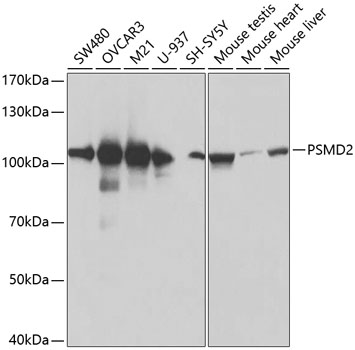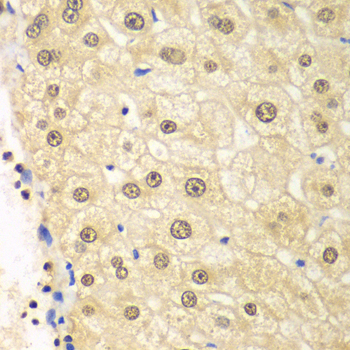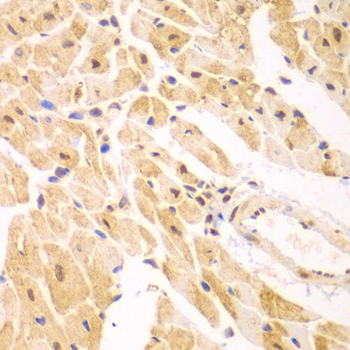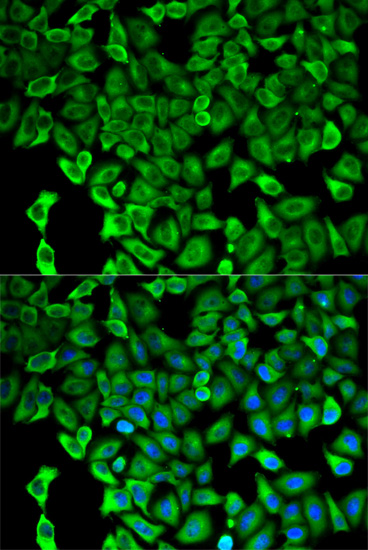Cell Biology Antibodies 8
Anti-PSMD2 Antibody (CAB1999)
- SKU:
- CAB1999
- Product Type:
- Antibody
- Reactivity:
- Human
- Reactivity:
- Mouse
- Host Species:
- Rabbit
- Isotype:
- IgG
- Research Area:
- Cell Biology
Description
| Antibody Name: | Anti-PSMD2 Antibody |
| Antibody SKU: | CAB1999 |
| Antibody Size: | 20uL, 50uL, 100uL |
| Application: | WB IHC IF |
| Reactivity: | Human, Mouse |
| Host Species: | Rabbit |
| Immunogen: | Recombinant fusion protein containing a sequence corresponding to amino acids 1-260 of human PSMD2 (NP_002799.3). |
| Application: | WB IHC IF |
| Recommended Dilution: | WB 1:500 - 1:2000 IHC 1:50 - 1:200 IF 1:50 - 1:200 |
| Reactivity: | Human, Mouse |
| Positive Samples: | SW480, OVCAR3, M21, U-937, SH-SY5Y, Mouse testis, Mouse heart, Mouse liver |
| Immunogen: | Recombinant fusion protein containing a sequence corresponding to amino acids 1-260 of human PSMD2 (NP_002799.3). |
| Purification Method: | Affinity purification |
| Storage Buffer: | Store at -20'C. Avoid freeze / thaw cycles. Buffer: PBS with 0.02% sodium azide, 50% glycerol, pH7.3. |
| Isotype: | IgG |
| Sequence: | MEEG GRDK APVQ PQQS PAAA PGGT DEKP SGKE RRDA GDKD KEQE LSEE DKQL QDEL EMLV ERLG EKDT SLYR PALE ELRR QIRS STTS MTSV PKPL KFLR PHYG KLKE IYEN MAPG ENKR FAAD IISV LAMT MSGE RECL KYRL VGSQ EELA SWGH EYVR HLAG EVAK EWQE LDDA EKVQ REPL LTLV KEIV PYNM AHNA EHEA CDLL MEIE QVDM LEKD IDEN AYAK VCLY LTSC VNYV PEPE NSAL LRCA LGVF RKFS |
| Gene ID: | 5708 |
| Uniprot: | Q13200 |
| Cellular Location: | |
| Calculated MW: | 82kDa/85kDa/100kDa |
| Observed MW: | 108kDa |
| Synonyms: | PSMD2, P97, RPN1, S2, TRAP2 |
| Background: | The 26S proteasome is a multicatalytic proteinase complex with a highly ordered structure composed of 2 complexes, a 20S core and a 19S regulator. The 20S core is composed of 4 rings of 28 non-identical subunits; 2 rings are composed of 7 alpha subunits and 2 rings are composed of 7 beta subunits. The 19S regulator is composed of a base, which contains 6 ATPase subunits and 2 non-ATPase subunits, and a lid, which contains up to 10 non-ATPase subunits. Proteasomes are distributed throughout eukaryotic cells at a high concentration and cleave peptides in an ATP/ubiquitin-dependent process in a non-lysosomal pathway. An essential function of a modified proteasome, the immunoproteasome, is the processing of class I MHC peptides. This gene encodes one of the non-ATPase subunits of the 19S regulator lid. In addition to participation in proteasome function, this subunit may also participate in the TNF signalling pathway since it interacts with the tumor necrosis factor type 1 receptor. A pseudogene has been identified on chromosome 1. Alternative splicing results in multiple transcript variants of this gene. |
| UniProt Protein Function: | PSMD2: Acts as a regulatory subunit of the 26 proteasome which is involved in the ATP-dependent degradation of ubiquitinated proteins. Belongs to the proteasome subunit S2 family. |
| UniProt Protein Details: | Protein type:Cell cycle regulation; Proteasome complex Chromosomal Location of Human Ortholog: 3q27.1 Cellular Component: cytosol; membrane; nucleoplasm; nucleus; proteasome complex; proteasome regulatory particle Molecular Function:endopeptidase activity; protein binding Biological Process: anaphase-promoting complex-dependent proteasomal ubiquitin-dependent protein catabolic process; antigen processing and presentation of exogenous peptide antigen via MHC class I, TAP-dependent; MAPKKK cascade; negative regulation of ubiquitin-protein ligase activity during mitotic cell cycle; positive regulation of ubiquitin-protein ligase activity during mitotic cell cycle; proteasomal ubiquitin-dependent protein catabolic process; protein polyubiquitination; regulation of amino acid metabolic process; regulation of mRNA stability; stimulatory C-type lectin receptor signaling pathway; T cell receptor signaling pathway; tumor necrosis factor-mediated signaling pathway; Wnt receptor signaling pathway, planar cell polarity pathway |
| NCBI Summary: | The 26S proteasome is a multicatalytic proteinase complex with a highly ordered structure composed of 2 complexes, a 20S core and a 19S regulator. The 20S core is composed of 4 rings of 28 non-identical subunits; 2 rings are composed of 7 alpha subunits and 2 rings are composed of 7 beta subunits. The 19S regulator is composed of a base, which contains 6 ATPase subunits and 2 non-ATPase subunits, and a lid, which contains up to 10 non-ATPase subunits. Proteasomes are distributed throughout eukaryotic cells at a high concentration and cleave peptides in an ATP/ubiquitin-dependent process in a non-lysosomal pathway. An essential function of a modified proteasome, the immunoproteasome, is the processing of class I MHC peptides. This gene encodes one of the non-ATPase subunits of the 19S regulator lid. In addition to participation in proteasome function, this subunit may also participate in the TNF signalling pathway since it interacts with the tumor necrosis factor type 1 receptor. A pseudogene has been identified on chromosome 1. Alternative splicing results in multiple transcript variants of this gene. [provided by RefSeq, Jul 2013] |
| UniProt Code: | Q13200 |
| NCBI GenInfo Identifier: | 6174930 |
| NCBI Gene ID: | 5708 |
| NCBI Accession: | Q13200.3 |
| UniProt Secondary Accession: | Q13200,Q12932, Q15321, Q53XQ4, Q96I12, B4DX07, B4DXY1 E7EW34, E9PCS3, |
| UniProt Related Accession: | Q13200 |
| Molecular Weight: | 85,606 Da |
| NCBI Full Name: | 26S proteasome non-ATPase regulatory subunit 2 |
| NCBI Synonym Full Names: | proteasome 26S subunit, non-ATPase 2 |
| NCBI Official Symbol: | PSMD2 |
| NCBI Official Synonym Symbols: | S2; P97; RPN1; TRAP2 |
| NCBI Protein Information: | 26S proteasome non-ATPase regulatory subunit 2 |
| UniProt Protein Name: | 26S proteasome non-ATPase regulatory subunit 2 |
| UniProt Synonym Protein Names: | 26S proteasome regulatory subunit RPN1; 26S proteasome regulatory subunit S2; 26S proteasome subunit p97; Protein 55.11; Tumor necrosis factor type 1 receptor-associated protein 2 |
| Protein Family: | 26S proteasome non-ATPase regulatory |
| UniProt Gene Name: | PSMD2 |
| UniProt Entry Name: | PSMD2_HUMAN |






![Anti-USP14 Antibody (CAB19998)[KO Validated] Anti-USP14 Antibody (CAB19998)[KO Validated]](https://cdn11.bigcommerce.com/s-rd6ounxcu2/images/stencil/590x590/products/56161/61343/anti-usp14-antibody-cab19998ko-validated__09737__08009.1706533777.jpg?c=1)
![Anti-TTLL12 Antibody (CAB19994)[KO Validated] Anti-TTLL12 Antibody (CAB19994)[KO Validated]](https://cdn11.bigcommerce.com/s-rd6ounxcu2/images/stencil/590x590/products/56157/61339/anti-ttll12-antibody-cab19994ko-validated__44806__14292.1706533776.jpg?c=1)
![Anti-MCAM Antibody (CAB19993)[KO Validated] Anti-MCAM Antibody (CAB19993)[KO Validated]](https://cdn11.bigcommerce.com/s-rd6ounxcu2/images/stencil/590x590/products/56156/61338/anti-mcam-antibody-cab19993ko-validated__34653__94345.1706533775.jpg?c=1)
![Anti-HNRNPR Antibody (CAB19999)[KO Validated] Anti-HNRNPR Antibody (CAB19999)[KO Validated]](https://cdn11.bigcommerce.com/s-rd6ounxcu2/images/stencil/590x590/products/56162/61344/anti-hnrnpr-antibody-cab19999ko-validated__57401__59079.1706533777.jpg?c=1)
![Anti-DSG2 Antibody (CAB19996)[KO Validated] Anti-DSG2 Antibody (CAB19996)[KO Validated]](https://cdn11.bigcommerce.com/s-rd6ounxcu2/images/stencil/590x590/products/56159/61341/anti-dsg2-antibody-cab19996ko-validated__26136__29974.1706533776.jpg?c=1)